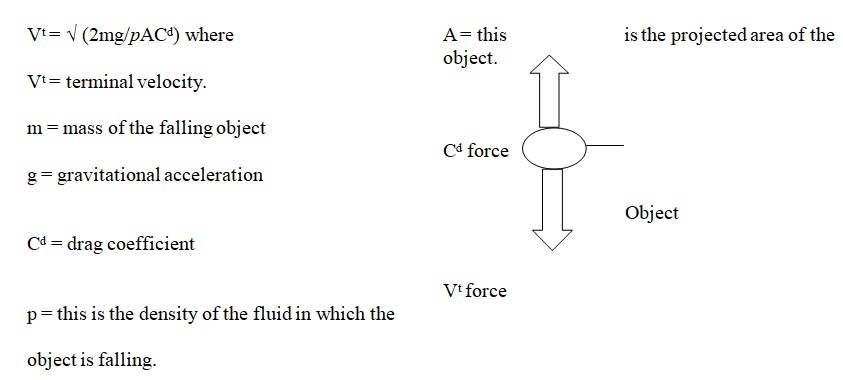Introduction
In physics, the term terminal velocity is that kind of velocity in which the force of drag of an object which is falling is equal to the weight of that object less the acting force due to air, which usually stops acceleration and causes the speed to remain constant.
When an object falls due to gravity and accelerates the drag which is produced by passing through a fluid medium and air increases. This reaches a particular speed when the drag force which is produced will equal to the gravity (downward) force and mostly the weight of the object. At this time this speed is called the terminal velocity. This terminal velocity varies directly with the ratio of drag to mass. This then means when the mass of the object is small the terminal velocity is lower, whereas increase in mass also means the higher terminal velocity. When an object falls at a speed which is greater than the terminal velocity, then it will have to slow down until it reaches the terminal velocity. This usually occurs when there are external effects that are associated with the body. Some of this effects are the downward force, when the shape changes or if it falls from a thinner part of the atmosphere.
Formula to find Terminal Velocity
This formula is usually used to calculate the terminal velocity without consideration of buoyancy.

The terminal velocity of an object usually changes due to the properties of mass, fluid and the projected area of the associated object. Ways to measure terminal velocity in presence of buoyancy To determine the terminal velocity, the drag force will be considered. This means that any calculation that is associated with terminal velocity will depend on the drag force. The terminal velocity in the presence of buoyancy force when buoyancy effects are brought into this issue and a body which is falling through a fluid under its weight reaches the terminal velocity when the velocity is settling (terminal velocity), this is where the net force which acts on the object becomes zero. When this period is reached the weight of the object is exactly balanced by the upward force of both buoyancy and drag. W = F + D where w = weight of the object, F = buoyancy force acting on the object and D = the drag force that acts on the object.
The above formula becomes; V = sqrt (4gd/3c ) Where d = diameter of the spherical object g = is the gravitational acceleration, ρ = is the density of the fluid, ρs = is the density of the object, C = is drag coefficient V = terminal velocity Ways to measure terminal velocity The frequent method that is used to measure the terminal velocity is the use of a stopwatch, an object, fluid or medium and measurement instrument. A distance in the open air such as that of skydiver is measured. The object is the thrown in a vertical down fall and at the same time the stop clock is started. When the object reaches the bottom the time is taken to calculate the drag force. This is also applicable to those cases that involve the fluids. The idea and the relationship between the mass and the nature of the testing environment influence the outcome. For example when an elephant falls it will never reach the terminal velocity compared to a feather. When the elephant tries to get resistance from the air, its weight is bigger hence the air resistance has no effect. This then brings another question about if the experiment is carried out in a vacuum? When different objects are experimented in a vacuum the free fall is the same and the time to reach the terminal velocity will depend on the mass of the object.
An example is the terminal velocity of a skydiver who is in a free fall position and using a semi closed parachute is approximately 195 km/hr or 120 mph or 54 m/s. usually, this velocity is the asymptotic that limits the value of acceleration process. This is so since the effective forces on the body are more closely balanced to each other as it is closely approached. The break down of this speed shows that, a speed of 50% of the terminal velocity is reached just after about 3 seconds, 90% after 8 seconds and 99% after 15 seconds.
Work Cited Sources
Blanche, McCrary. Terminal Velocity, London: Knopf, 1997.
Johnnie, T. The Complete Idiot’s Guide to Physics, New York: Prentice Hall, 2003.
Molly Guy, Terminal Velocity, New York: Interactive Press, 2003.